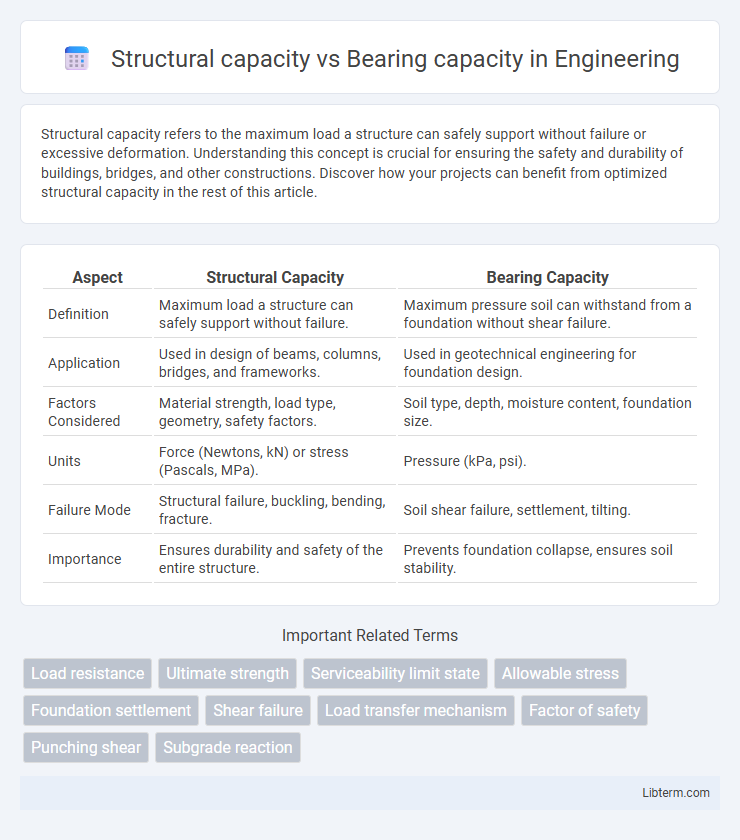Structural capacity refers to the maximum load a structure can safely support without failure or excessive deformation. Understanding this concept is crucial for ensuring the safety and durability of buildings, bridges, and other constructions. Discover how your projects can benefit from optimized structural capacity in the rest of this article.
Table of Comparison
| Aspect | Structural Capacity | Bearing Capacity |
|---|---|---|
| Definition | Maximum load a structure can safely support without failure. | Maximum pressure soil can withstand from a foundation without shear failure. |
| Application | Used in design of beams, columns, bridges, and frameworks. | Used in geotechnical engineering for foundation design. |
| Factors Considered | Material strength, load type, geometry, safety factors. | Soil type, depth, moisture content, foundation size. |
| Units | Force (Newtons, kN) or stress (Pascals, MPa). | Pressure (kPa, psi). |
| Failure Mode | Structural failure, buckling, bending, fracture. | Soil shear failure, settlement, tilting. |
| Importance | Ensures durability and safety of the entire structure. | Prevents foundation collapse, ensures soil stability. |
Introduction to Structural and Bearing Capacity
Structural capacity defines the maximum load a structure can safely withstand without failure, encompassing factors like material strength, design, and load distribution. Bearing capacity specifically refers to the ability of soil or foundation material to support imposed loads without experiencing shear failure or excessive settlement. Understanding both structural and bearing capacity is crucial for ensuring stability and safety in construction and civil engineering projects.
Defining Structural Capacity
Structural capacity refers to the maximum load a structure can safely support without experiencing failure or excessive deformation. It encompasses the overall strength, stability, and durability of the entire structural system under various types of loads, including dead loads, live loads, wind, and seismic forces. Unlike bearing capacity, which specifically addresses the soil or foundation's ability to support loads, structural capacity evaluates the performance and resilience of beams, columns, slabs, and connections within the built structure itself.
Understanding Bearing Capacity
Bearing capacity refers to the maximum load a soil can support without experiencing shear failure, crucial for foundation design and structural safety. It depends on soil properties such as cohesion, density, moisture content, and internal friction angle, which directly influence the stability of the foundation. Accurate evaluation of bearing capacity ensures that the structural capacity of a building does not exceed the soil's ability to support it, preventing excessive settlement or collapse.
Key Differences Between Structural and Bearing Capacity
Structural capacity refers to the maximum load a structure can safely support without failure, encompassing factors like material strength, design, and load distribution. Bearing capacity specifically denotes the ability of soil or foundation to support the loads transmitted from the structure without undergoing shear failure or excessive settlement. Key differences include structural capacity focusing on the overall integrity of the built framework, while bearing capacity concentrates on the soil or foundation's ability to support imposed loads.
Factors Affecting Structural Capacity
Structural capacity depends heavily on material properties such as strength, elasticity, and durability, which influence how a structure withstands loads without failure. Design factors like geometry, load distribution, and support conditions also critically impact structural capacity by determining stress concentration and deformation patterns. Environmental effects including temperature, corrosion, and wear further affect the long-term performance and safety margins of structural systems.
Factors Influencing Bearing Capacity
Bearing capacity depends on soil properties such as cohesion, internal friction angle, density, and moisture content, which directly influence its ability to support loads without failure. Structural capacity involves the strength and design of the construction materials and elements, but bearing capacity specifically addresses the soil's resistance beneath foundations. External factors like water table level, soil stratification, and loading conditions also critically affect bearing capacity, determining safe foundation design parameters.
Methods for Evaluating Structural Capacity
Evaluating structural capacity involves analytical methods such as finite element analysis (FEA), load testing, and strain gauge measurements to determine a structure's ability to withstand applied loads without failure. Bearing capacity assessment primarily uses geotechnical techniques including in-situ tests like the Standard Penetration Test (SPT), Plate Load Test, and Cone Penetration Test (CPT) to evaluate soil's ability to support structural loads. Advanced numerical simulations and empirical correlations also aid in accurately predicting both structural and bearing capacities under various loading and environmental conditions.
Techniques for Assessing Bearing Capacity
Techniques for assessing bearing capacity include in-situ tests such as the Standard Penetration Test (SPT), Cone Penetration Test (CPT), and Plate Load Test, which provide critical data on soil strength and deformation characteristics. Laboratory tests like triaxial shear tests and unconfined compression tests offer detailed insight into soil shear strength parameters essential for bearing capacity calculations. Advanced geotechnical software integrates these test results to model and predict bearing capacity accurately under varying structural load conditions.
Implications for Design and Construction
Structural capacity defines the maximum load a structure can safely support without failure, while bearing capacity refers to the soil's ability to support the load transmitted from the foundation. Accurate assessment of bearing capacity is crucial for foundation design to prevent excessive settlement or shear failure, directly influencing structural stability and safety. Integrating both capacities ensures optimized material use, cost efficiency, and compliance with safety standards during construction.
Conclusion: Integrating Structural and Bearing Capacities in Engineering
Integrating structural capacity and bearing capacity is essential for ensuring the overall stability and safety of engineering projects by balancing load-bearing limits with material strength. Structural capacity focuses on the strength and deformation limits of components, while bearing capacity addresses the soil's ability to support loads without failure. Coordinated assessment of both capacities optimizes design efficiency, prevents infrastructure failures, and extends the service life of foundations and superstructures.
Structural capacity Infographic

 libterm.com
libterm.com